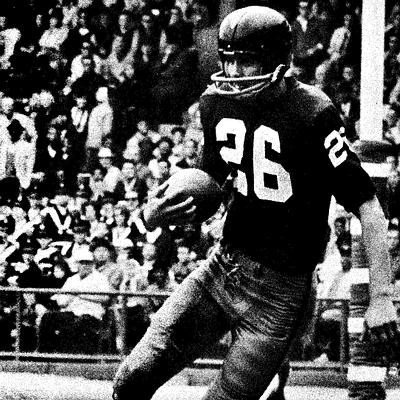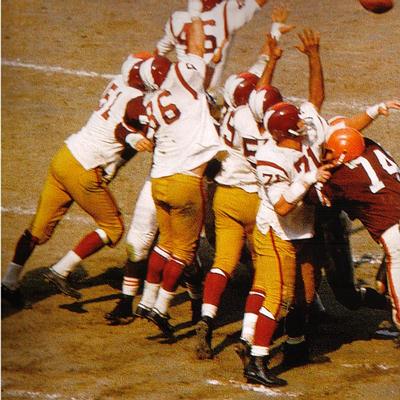

"Paul Krause"
In last month's installment, I summarized my early encounter with the University Of Iowa Hawkeyes on television, the Rose Bowl performances of their great backs Willie Fleming and Bob Jeter, and the way in which Paul Krause caught my attention in 1962 and '63. Coincidentally, my first roommate at Cincinnati had played at Weir High School in Weirton, West Virginia and enthusiastically described his high school career and the pride he had in the football played there. He noted that "all the Jeter boys" from Weirton were great athletes, including Bob's brother Tony who was a tight end at Nebraska. Bob had started at the segregated Dunbar High School and then finished at Weir High School while Tony attended Weir and his high school career overlapped one season with my roommate. Even with my limited knowledge, I realized that Bob Jeter had left Iowa and played in Canada before becoming a star defensive back for the Packers and it was him and Krause that had made me interested in Iowa. When Krause, one of the best defensive backs in the nation, was chosen to play in the collegiate post-season and entered the field wearing a Redskins' helmet, the beautiful and unique "feather helmet" design instead of his Iowa helmet, I flipped!
For the 1958 season the Redskins, a very mediocre outfit in the mid-Fifties through the late-1960's, donned the gold helmet that they had worn since the start of the 1957 season until their
December 7th game against the Steelers. In both that game and the
December 14th finale against Philadelphia, they introduced what most
helmet fans believe to be one of the absolute best and most
beautiful helmet designs, the complex, multi-colored thin feather
decal in the rear of the helmet. With their all-burgundy jerseys, it
made for a classic yet unique and riveting appearance. One look at
the HELMET HUT REDSKINS SECTION in the NFL area of the site will
confirm the beauty of this very timeless presentation. But why I
wondered, was Krause wearing it in what was to me, a college ball
game? As all football fans know, Paul Krause was every bit as good
in the pro ranks as he was at Iowa, perhaps better as he matured and
became more experienced. No longer a two-way player as the college
game demanded, Krause became an excellent defensive back and earned
a reputation as a vicious hitter as well as a ball-hawk. At 6’3” and
200 pounds, Krause was a lean, fast ball of fury and the Redskins
both needed him and were determined to sign him.
 |
The Redskins
drafted Krause on December 3, 1963, the day the NFL held their
common draft of collegiate players. The Denver Broncos of the AFL,
believing that Krause-to-the-NFL was more or less a done deal, opted
to draft him but held off until their twelfth pick. At that time,
Denver especially among the emerging AFL teams did not have a lot of
money to spend on draft choices. Krause was the eighteenth overall
choice in the NFL draft and the Redskins’ number-two pick, following
Arizona State halfback Charley Taylor. Wow, think about that for a
moment, the lowly Redskins choosing two future Pro Football Hall Of
Fame players on successive rounds in one draft. Even with fewer
teams and a greater probability of choosing a serviceable player in
each of the first eight or ten rounds, unlike today, this was an
exceptional event. Krause was an immediate hit with the ‘Skins,
intercepting passes in seven consecutive games! Incredibly the
Redskins traded Krause to the Vikings in 1968 even though he
intercepted twenty-eight passes during his first four seasons. The
Redskins, known for ineptitude, negated the efficacy of their ’64
draft by under-utilizing Taylor as a running back in his first few
seasons and then trading Krause for Marlin McKeever and a paltry
seventh-round choice in the 1968 draft. That pick turned out to be
Louisiana Tech halfback Bobby Brunet who was twice named to the All
Gulf States Conference team and by the fifth game of his rookie
season with the ‘Skins, was a starter, contributing 227 rushing
yards which made him the team’s second-leading ball-carrier, and he
caught passes for another 160. As a point of trivia, Brunet, from
Larose, Louisiana, was one of two players from Lafourche Parish that
the Redskins drafted that year, linebacker Tommy Roussel of
Thibodaux and Southern Miss being the other. While Brunet and
McKeever were good players, the Vikings got the better of the deal
as in sixteen seasons, Krause retired with eighty-one interceptions
which made him the all-time NFL leader.
 |
Perhaps the Broncos’ assumption that Krause was in fact committed to Washington was correct and the Redskins provided their beautiful feather helmet for the all star game to emphasize that point. Krause was the only player on the field with a helmet that did not represent his college, thus the Redskins helmet, distinctive under any circumstances, truly stood out. Already having a “soft spot” for the Redskins who had placed only Bobby Mitchell on the ’63 All Pro squad, and who featured two of my favorite fullbacks, former University Of Miami great Don Bossler (see HELMET HUT’s feature on the UNIVERSITY OF MIAMI helmets in the COLLEGE SECTION) and relatively unknown Joe Cunningham who had played at Pitt and who would later be a solid performer in the Continental Football League for both Wheeling and Ohio Valley, it was exciting to see that helmet on the field in what was to me, a college contest. Paul Krause went on to star for the great Minnesota Viking teams, an integral part of their Super Bowl squads. Even as a Hall Of Fame player, he remained somewhat underrated and under appreciated by the average fan. Typical of the Redskins of that era, and certainly until first Vince Lombardi and then George Allen molded them into winners, they traded one of their most valuable assets but provided helmet fans like me, with a number of thrills, and Krause wearing his feather headgear was one of them.